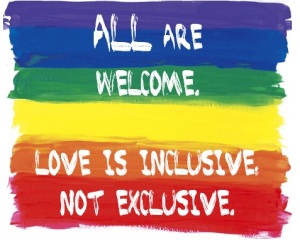Yesterday, I went to drop off some waivers to some of my students going to Valleyfair with me on Saturday. Each of the kids in the youth group can bring one friend with them on this trip. As I was standing in the entry, I heard hushed conversations between the kids.
What rang clear was, “Why don’t you just ask? He’s your friend.”
Two of my students walked down the steps along with a friend of theirs. Their friend asked, “Are Muslims welcome?”
Without hesitation, I say, “Of course!”
My older students says “Seeeee! I told you!” in an taunting voice, like it was an obvious yes.
Currently, I am reading What’s the Least I can Believe and Still be a Christian?: A Guide to What Matters Most by Martin Thielen for research for the series of hard questions I am exploring with my high schoolers this fall. Chapter 10 discusses the implications of judgmental Christianity and the damage it can do to people in and outside of the church. To conclude the end of the chapter, Thielen tells a story of a good friend who stopped attending church while going through messy divorce. A co-worker of the friend started pestering him to attend her church.
“One day she asked my friend, ‘Don’t you want to go to heaven?’ In weary exasperation he responded, ‘Not if it’s full of people like you’” (page 63).
And honestly, I feel quite the same way. The concluding line of the chapter is, “True Christians leave judgment to God.” Though I’m guessing for the young guy in my story above, there have been plenty of activities he has not be welcome to attend, plenty of criticism from other students who learned hate from the adults surrounding them, and plenty of sneers and jeers from people who hold prejudices. This is exactly the reason why we all need to strive for religious understanding and acceptance of others’ beliefs. When kids have to ask “Am I welcome?” because of exposure to judgmental Christianity, we have giant problem.
In Acts 10, there is a story of Peter and Cornelius. Cornelius, a centurion, has a vision and sends for Peter. When Peter arrives, Cornelius falls to Peter’s feet, but “Peter made him get up, saying, ‘Stand up; I am only a mortal’” (v. 26). They continued to talk and went inside to find that many people had assembled. Peter said, “You yourselves know that it is unlawful for a Jew to associate with or to visit a Gentile; but God has shown me that I should not call anyone profane or unclean” (v. 28). He continues, “I truly understand that God shows no partiality, but in every nation anyone who fears [God] and does what is right is acceptable to [God]. You know the message [God] sent to the people of Israel, preaching peace by Jesus Christ–[God] is Lord of all” (v. 34-36).
The disciples had to learn that they needed to interact with people of different faiths. Peter learned this through a vision that he had that all are welcome. Jesus cared for the outcasts, welcomed people of all religions, and loved the ones who society did not. Jesus called all to that life as well. We are called to welcome people into our communities.
Think about how many times this 6th grader has heard “You aren’t welcome” to have to ask me if he was allowed to come with us to Valleyfair. It honestly breaks my heart. My youth group will always be one where all are welcome. Because All are Welcome is one of my favorite hymns, I will leave you with the first stanza that guides my steps as I build my youth ministry.
Let us build a house where love can dwell and all can safely live,
a place where saints and children tell how hearts learn to forgive.
Built of hopes and dreams and visions, rock of faith and vault of grace;
Here the love of Christ shall end divisions;
All are welcome, all are welcome.
All are welcome in this place.
Photo from patheos.com












